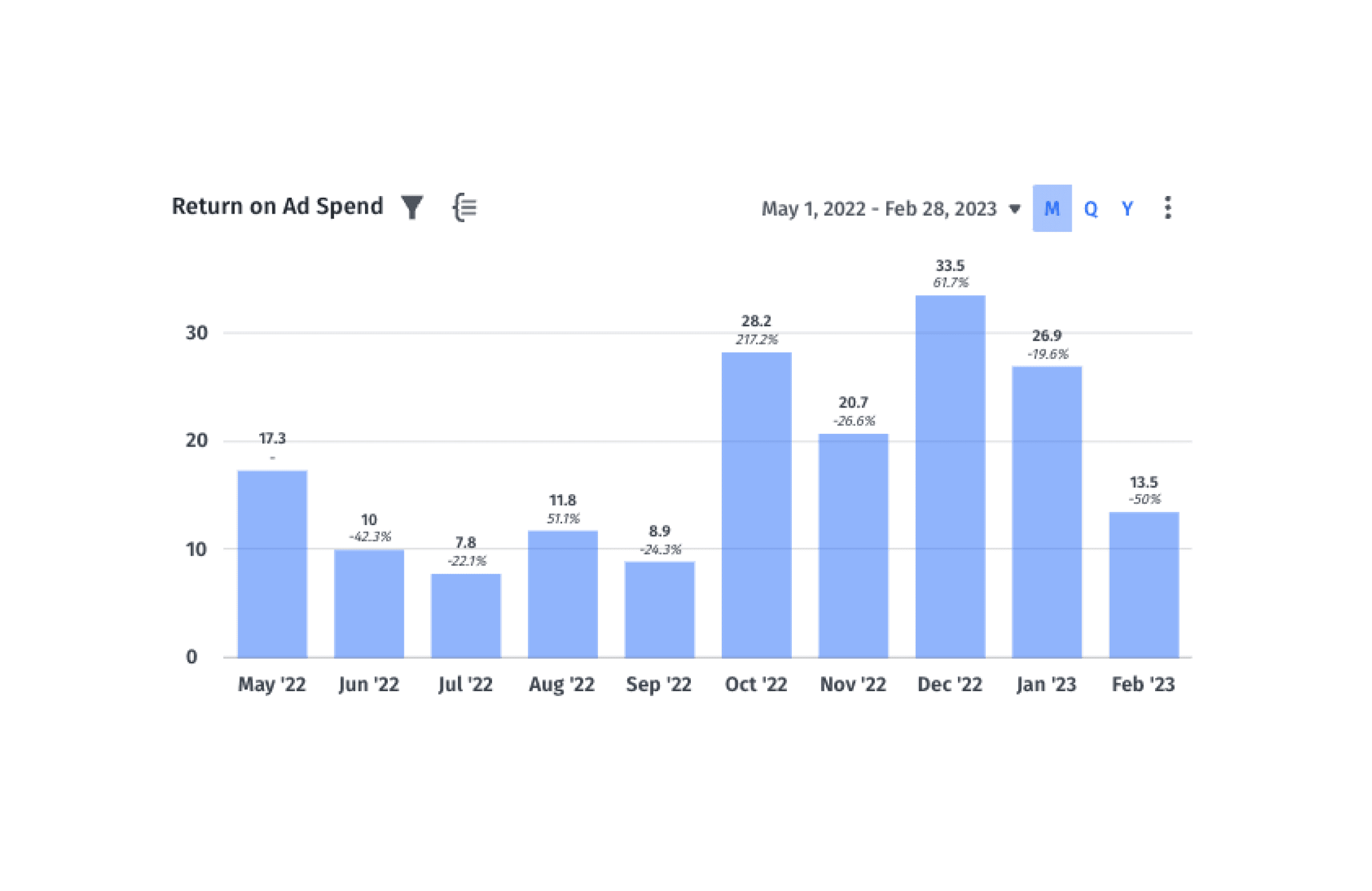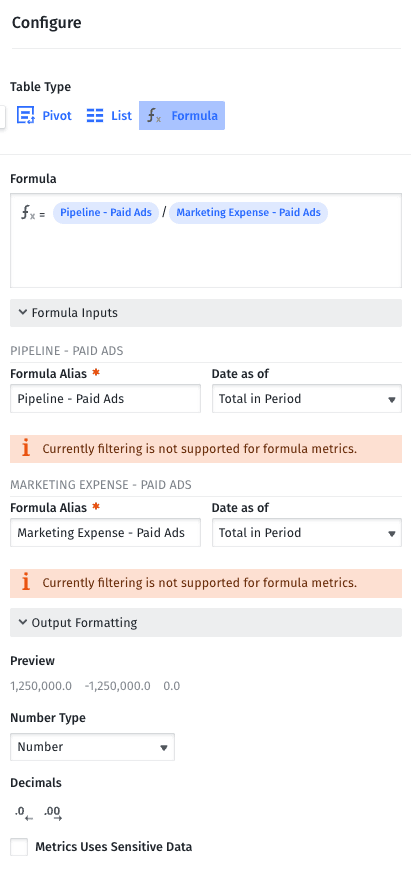Return on Ad Spend: What it Means and How to Calculate This Metric
What Is Return on Ad Spend (ROAS)?
Return on ad spend, or ROAS, is a crucial marketing and advertising metric used to evaluate the effectiveness of an ad campaign which measures the amount of revenue generated by the campaign relative to the cost. It’s an important metric for any business leveraging paid channels for growth, and it gives finance leaders an understanding of the return on investment of paid marketing efforts.

Categories
Table of Contents
Why Is ROAS Important?
Companies that rely heavily on digital advertising to acquire new customers and grow their businesses need to track ROAS to understand how much they should spend on ads and optimize paid strategies. While you’ll see ROAS come up in discussions for SaaS and ecommerce businesses most often, it’s universally applicable to any company leveraging paid strategies for growth in any industry.
While ROAS measures the bigger picture of your paid marketing ROI, the real value comes from evaluating the KPI on a channel-by-channel basis. When you do, you can:
Improve Budget Allocation
Identify which ad campaigns are generating higher ROAS and double down. Ad platforms with low ROAS don’t necessarily need to be shut off, but teams should be taking a close look at how large a part they should play in the broader digital marketing strategy.
Optimize Marketing Strategies
The overarching marketing strategy should map back to your company’s top-line financial goals. Solid ROAS calculations enable the marketing team to forecast results more accurately, improving conversations with finance and executive partners. While there may be reasons why some ad platforms drive more revenue than others — maybe you’re fully focused on brand awareness in one, whereas another is more about bottom-funnel conversions — baseline knowledge of ROAS is critical to conversations about proper attribution and future investments.
Reassess Your Bidding Strategy
Your bidding strategy can make all the difference between good ROAS and sub-par returns in a channel like Google PPC. Set a target ROAS and monitor it as closely as possible so you can adjust the bidding strategy as needed. This information can help you set negative keywords to further optimize your targeting.
How to Calculate Return on Ad Spend
The formula for calculating your return on ad spend is pipeline from paid ads divided by total marketing expense on those paid ads. You can swap out pipeline for revenue if you want a clearer picture of end-to-end attribution. And you can run the calculation for specific channels or campaigns rather than the paid advertising strategy as a whole.

Look at PPC spend on Google as an example. Your actual expenses from the month on that channel are $30,000. If those ads generated 12 opportunities for the business at an ACV of $20,000, you would have driven $240,000 in pipeline. The ROAS calculation would be:
$240,000 in pipeline / $30,000 in cost of ads = 8
What this means is that for every $1 you spent on Google Ads, you generated $8 in pipeline for the business.
You can take the calculation further by replacing pipeline with total revenue. If those 12 opportunities turned into 5 closed-won deals at $130,000 ARR, your ROAS would be:
$130,000 in revenue / $30,000 in ad spend = 4.33
ROAS Calculator
Your Return on Ad Spend
0
Challenges of Maximizing ROAS
There’s a science to digital advertising, but there are so many nuances to success that make maximizing your ROAS a challenge.
If you’re not happy with your average ROAS, there are a few issues you might be dealing with.
Finding the Right Target Audience
One major challenge in maximizing ROAS is identifying and targeting the right audience for your specific ad campaign. A poorly targeted campaign may result in wasted ad spend, as it fails to reach potential customers who are interested in your product or service.
You may need to invest in data enrichment to narrow down your ICP. Or, you may need to spend more time in the weeds of each ad platform to further refine your targeting parameters. Ad platforms are designed to push you to continue spending more and more money, so you have to master both the art and science of targeting as defined by each one. Would your company benefit from bringing on a digital ads manager to focus 100% on optimizing campaigns?
Defining a Good ROAS for Your Business
There are many different variables to consider when setting your ad budget and thinking about what a “good” ROAS is for your business. Everything from risk tolerance to CAC payback period, customer lifetime value (LTV), business maturity, profit margins, total addressable market, attribution model, and average sales cycle comes into play.
A “growth at all costs” mindset might push you to set your ROAS benchmark as whatever matches advertising costs with LTV:CAC regardless of payback period so you can drive up customer count. Later-stage companies might be more conservative and focus the benchmark on average ARR per customer rather than LTV:CAC. Industry rules of thumb may say that ROAS of 4:1 is good, but you should benchmark the metric for yourself.
Maintaining High-Quality Ad Content & Creative Designs
The financial side of ROAS is the science, but the creative side is just as important to maximizing returns. However, it can be difficult to overcome creative fatigue and continuously improve ad relevance. Ensuring that your ads are relevant and fresh to your target audience is crucial for maximizing ROAS. Irrelevant or poorly designed ads may lead to low click-through rates (CTR) and high bounce rates, ultimately affecting the overall performance of a marketing campaign.
Navigating Algorithm Changes & Platform Updates
Digital advertising platforms like Google Ads and Facebook Ads frequently update their algorithms, which can impact the campaign performance. Staying abreast of these developments is critical for achieving desirable outcomes from your ad investment. Finance leaders must work closely with their marketing teams to adapt strategies accordingly when faced with algorithm updates or platform policy changes.
Data Analysis & Measuring Return Accurately
An accurate calculation of return on ad spend requires reliable data analysis tools that provide real-time insights into revenue generated by specific campaigns. Manual calculations can be prone to error, leading finance leaders astray in determining the effectiveness of advertising efforts. Ad platforms can give you rough ROAS metrics for specific channels, but you need to be able to reliably bring data together from all channels to assess ROAS effectively.
Strategies to Increase Return on Ad Spend
So much of optimizing ROAS happens on the granular level within the ad platforms themselves — tweaking keyword lists, reallocating budget, swapping out under-performing campaigns for new or better ones.
But if you’re taking a step back and looking at the financial success of your paid marketing channels and looking to improve ROAS, there are a few high-level things to look at:
Channel Strategy
You can run ads on every single platform imaginable — but that doesn’t mean you should. Look at ROAS across channels and do a “start, stop, keep” analysis of current spend. Because ROAS is a lagging indicator of success, you should be doing this regularly to make sure you’re spending money on channels that deliver the most value for your budget.
A/B Testing
Staffing for paid advertising isn’t just about keeping the lights on by spreading budget across channels. Creative matters. Make sure you have the staff to experiment with different headlines, images, or calls to action. Give each channel and campaign the attention needed to know if it works or not.
Landing Page Optimization
Strong clickthrough rates are meaningless if they aren’t joined by strong conversion rates. If the cost per click is going to be worth it, you need to ensure that landing pages are relevant, engaging, and easy to navigate so users have a seamless experience after clicking through an ad.
Increase ACV and LTV
Outside of the marketing team, you can improve ROAS by increasing contract and lifetime values. The higher the amount of money you’re pulling in from individual customers, the more return each opp driven through paid ads will generate.
Stay on Top of ROAS with Mosaic’s Metric Builder
Calculating ROAS seems simple on the surface. But in reality, it’s one of the harder metrics to stay on top of and measure accurately at all times. The issue is less about the formula and more about the effort it takes to constantly pull data from disparate platforms, ensure attribution is correct, and combine the data for a holistic picture of ROAS.
Mosaic makes calculating ROAS easy by integrating with your ERP, CRM, and marketing automation platforms to aggregate ad spend and pipeline data automatically. Use Metric Builder to customize the formula for your specific business needs. Track down to the campaign or channel levels. Use pipeline or revenue as the key variable depending on your go-to-market motion. And add any other data filters to make sure you’re always measuring ROAS accurately.

Metric Builder gives you the power and flexibility to get real-time, accurate insight into ROAS. Want to see how it works? Request a personalized demo and find out how Mosaic can streamline planning and analysis in your business.
Improve ROI on Sales & Marketing Spend with Mosaic
Return on Ad Spend FAQs
What is the difference between ROAS and ROI?
Return on ad spend (ROAS) is a subset of return on investment (ROI). Whereas ROI can apply to any activity in the business, ROAS is specifically about the returns generated from ad spend.
What is the average return on ad spend in the US?
How can Mosaic help with ROAS?
How do you calculate return on ad spend?
Explore Related Metrics
Own the of your business.




